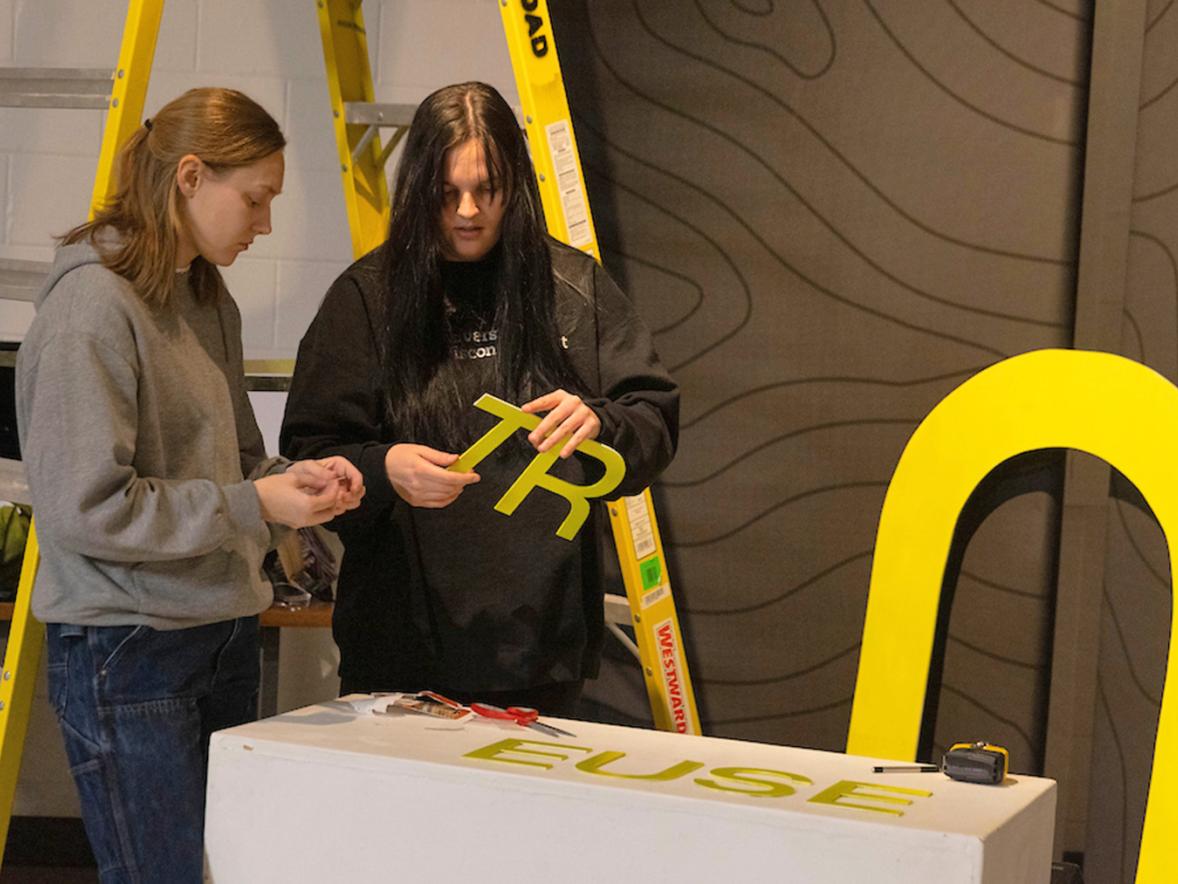Every spring, UW-Stout’s Furlong Gallery in Micheels Hall celebrates the creativity and discipline of students in the School of Art and Design.
From April 21 through Saturday, Sept. 10, the gallery will feature the final shows of the 2021-22 academic year: the Best of Design Juried Exhibition in the larger space and the Student Artist in Residence in the south space.
Lecturer Jonny Wheeler was honored to help put the show together. “I’ve been so impressed by the tremendous work produced by the design students,” he said.
The exhibits feature the works of more than 40 students.
Industrial design senior has three pieces in juried exhibit
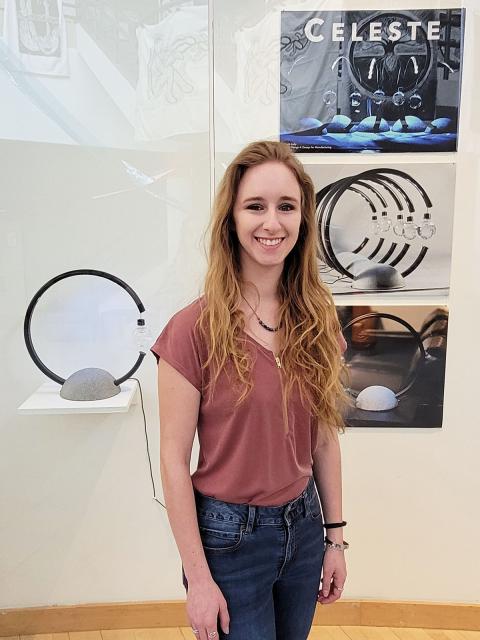
Elizabeth Kelly, an industrial design graduating senior, has three pieces in the exhibit: “Celeste Lamp,” “UV Bag” and “Room & Board Project.”
Kelly attended LakeView Technology Academy, a vocational high school in Kenosha. In the engineering program, she found her love for design. Her teacher, Matthew Schultz, was a UW-Stout technology education alum and had a lot of influence on her development, she said.
Schultz headed the Supermileage Vehicle Club at the academy, where Kelly learned the process of design through problem solving to create a working vehicle ready to race.
“This club helped me develop my skills as a designer and led me to wonder about my career,” she said. “Mr. Schultz recommended the industrial design program at Stout, which has been a perfect fit for my interests and who I am as a person. I am most thankful. I wouldn't have found industrial design without him or my experience at LakeView.”
Kelly created “Celeste Lamp” during her Design for Manufacturing class, where students designed a lamp and reproduced it five times.
“Our teacher, David Richter O'Connell, always tells us to push our designs and go out of the box on ideas,” Kelly said. “For this project, I wanted to challenge myself and use materials or processes I haven't before.”
Kelly incorporated concrete into her design as she felt it had a lunar feel and researched forms of lighting, such as glowing algae or dinoflagellates. With the arced form of the lamp, she was inspired by the anglerfish, a deep-sea predator that lures its prey into its gaping jaws using a glowing appendage on its forehead.
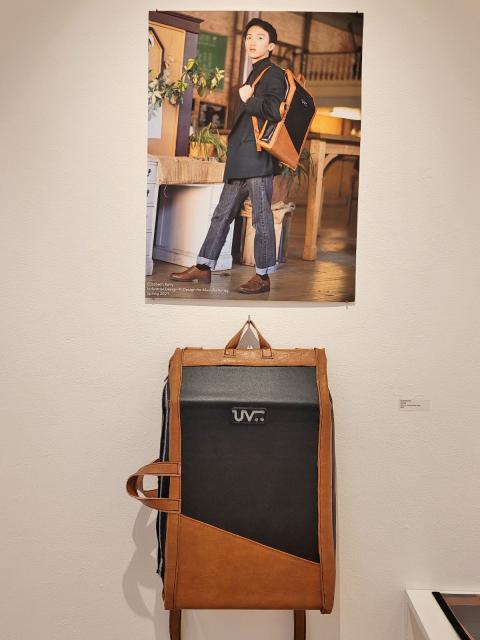
The lamp has an LED color-changing strip in the metal curvature, from which a small glass globe, filled with the glowing algae, dangles. The algae, since it's an animal, requires maintenance and has its own natural sleep schedule, Kelly explained.
For the algae to glow, it must be dark and there must be water movement. She used magnets in the globe to create a bouncing movement, similar to an anglerfish.
Kelly created her second piece, “UV Bag,” during her Product Interface class. She was assigned to create a wearable product for the COVID environment.
“I wanted to learn how to sew, so I decided to design a bag for the office space that also incorporated UV lighting technology within the bag to clean any of the products that are within the bag,” she said.
She machine- and hand-stitched the bag at home. The logo on the front has a power button, which activates interior UV lights. The lights only work when the zipper is fully shut to avoid any UV light harm, Kelly explained.
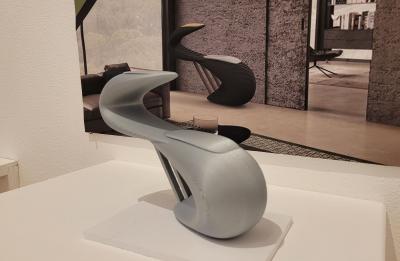
Kelly’s third piece in the exhibit, “Room & Board Project,” was her senior capstone project, sponsored by the Room & Board company.
Using the additive manufacturing process, she designed a table bench for an entryway or office space, incorporating sustainable materials such as seaweed fabric, reclaimed ash wood and algae-based filament.
“For this project, the material inspired my form,” Kelly said. “I wanted to showcase an organic form derived from looking at kelp and seaweed in the ocean.”
The curve and flow of the bench suggests movement of seaweed in a gentle current. Kelly printed a miniature of the table bench in UW-Stout’s 3D Print Lab.
Kelly presented “Room & Board Project” at the SOAD Senior Show on May 6.
‘Top Dog’ team collaborates on video game
A team of third-year students teamed up to create “Top Dog,” a single-player, turn-based strategy video game. In a friendly annual tournament, players battle as an Old English Sheepdog to win a year’s supply of dog treats.
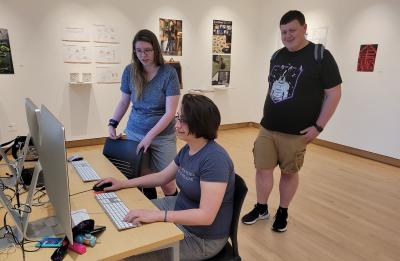
Game design and development-art majors Hailee Kane of Rosemount, Minn., and Audrey Lawson of La Crosse, joined talents with computer science majors and programmers Joshua Armbrecht of Algonquin, Ill.; Taylor Kinsella of Denmark, Wis.; and Jaydon Pfab of Warrens.
They worked together during their 2D Game Design and Development course with Associate Professor Seth Berrier.
Kane was inspired by a video she saw of a Shiba Inu dog and thought, "I could make a game out of this. This game was my baby. I’m very proud of how it turned out,” she said.
The team took gameplay inspiration from the "Mario and Luigi" series. Designed to look like a friendly gladiator, the player, as the sheepdog, engages in three arena battles, with each new opponent more daunting than the last. Players select attack modes and then play minigames to test their memory or reflexes, to have the attack be successful or to gain back health or stamina.
Players may earn items that are unlocked after completing a battle, like new gladiator garments or weapons. “This allows the player to customize themselves and experiment in preparation for the final battle against Slobberus,” Kane said.

Most of the characters are based on the team members’ pets: Gizmo is Kane’s dog; Danny is Lawson's dog; and Slobberus, whose name is inspired by Cerberus, the three-headed giant dog of Greek myth, is a combination of the programmers' dogs Bella, Rufus and Otto.
Even the shopkeeper is Berrier’s cat, disguised as a dog.
They collaborated with Sage Moser, a student at Michigan Tech, who designed audio for the game. Berrier arranged a virtual chat for the class to meet with an audio design class at Michigan Tech, giving them a synopsis of their games. Moser chose to join the “Top Dog” team, creating chipper music for the environment and battle-themed music in the arena, again inspired by “Mario and Luigi.”
Students recognized for creative excellence in design
An artists’ reception was held on May 6 in the Micheels Hall Atrium before the SOAD Senior Show. Students awarded Best in Category during the reception were:
- Animation and digital media: Kayla Miller, character idle and attack animations
- Design foundations: Jordan Miinch, postcard project
- Game design: Alexander Ewell, Carter Gehl, Elizabeth Geoffrey and Tanner Tilkens, “Death’s Dog” game
- Graphic design: Claire Schardin, transgender posters
- Industrial design: Michael Wolff, “The Buddy System”
- Interior design: Emma Caldwell, “The Vega House”
- Video and music: Kyle Burger, Kelsey Galbraith, Delaney Hoffman and Jesse Stark, video and audio soundtrack “Safe Haven.”
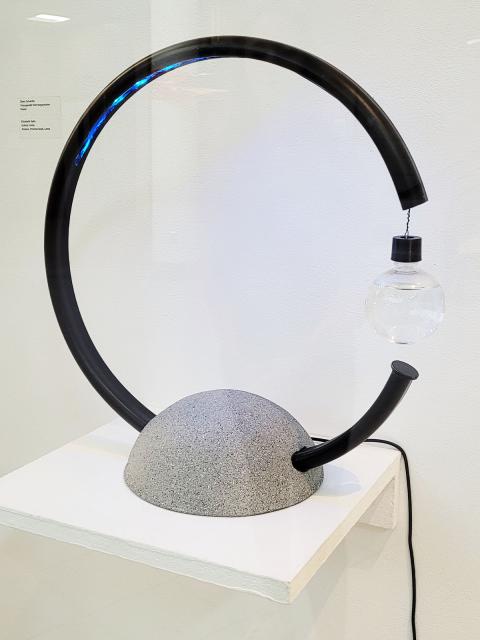
Kelly was awarded Best in Show for “Celeste Lamp.”
This year’s Student Artists in Residence are studio art seniors Ezra Brey, of Stillwater, Minn.; and Kayla Haugen, of Woodbury, Minn. Their exhibit has a shared title, “Traces.”
Each year, the Student Artist in Residence program awards two School of Art and Design students with a grant of $2,000 each. They receive a dedicated studio and exhibition space, resulting in a body of work created over the course of the year. The program was created through a gift by Bud and Betty Micheels to the Stout University Foundation.
Next year's SAIRs recipients were named at the awards ceremony: studio art majors Eliza Jorgenson, of Hudson; and Ray Pagenkopf, of McFarland.
The Noah Norton Portfolio Prize Endowed Fund winner was announced during the Senior Show. Anna Lindner, an industrial design junior from Hastings, Minn., was awarded the $1,000 prize. The endowed fund is named in honor of Norton, a former associate professor and the university’s first program director of industrial design. Norton died from leukemia in April 2017. He earned his bachelor’s degree from UW-Stout.





